Heel Pain Treatment Cartersville GA
Heel Pain
Finding heel pain treatment is important since it is difficult for most people to remain inactive until the discomfort subsides.
Heel pain is generally the result of faulty biomechanics (walking gait abnormalities) that place too much stress on the heel bone and the soft tissues that attach to it.
The stress may also result from injury, or a bruise incurred while walking, running, or jumping on hard surfaces; wearing poorly constructed footwear; or being overweight.
It is important to get the proper treatment for heel pain before it gets worse.
Common Causes of Heel Pain:
Plantar Fasciitis
Both heel pain and heel spurs are frequently associated with an inflammation of the band of fibrous connective tissue (fascia) running along the bottom (plantar surface) of the foot, from the heel to the ball of the foot.
The inflammation is called plantar fasciitis. It is common among athletes who run and jump a lot, and it can be quite painful.
The condition occurs when the plantar fascia is strained over time beyond its normal extension, causing the soft tissue fibers of the fascia to tear or stretch at points along its length; this leads to inflammation, pain, and possibly the growth of a bone spur where it attaches to the heel bone.
The inflammation may be aggravated by shoes that lack appropriate support, especially in the arch area, and by the chronic irritation that sometimes accompanies an athletic lifestyle. Resting provides only temporary relief.
When you resume walking, particularly after a night’s sleep, you may experience a sudden elongation of the fascia band, which stretches and pulls on the heel.
As you walk, the heel pain may lessen or even disappear, but that may be just a false sense of relief. The pain often returns after prolonged rest or extensive walking.
Excessive Pronation
Heel pain sometimes results from excessive pronation. Pronation is the normal flexible motion and flattening of the arch of the foot that allows it to adapt to ground surfaces and absorb shock in the normal walking pattern.
As you walk, the heel contacts the ground first; the weight shifts first to the outside of the foot, then moves toward the big toe.
The arch rises, the foot generally rolls upward and outward, becoming rigid and stable in order to lift the body and move it forward. Excessive pronation—excessive inward motion—can create an abnormal amount of stretching and pulling on the ligaments and tendons attaching to the bottom back of the heel bone. Excessive pronation may also contribute to injury to the hip, knee, and lower back.
Some general health conditions can also bring about heel pain
- Rheumatoid arthritis and other forms of arthritis, including gout, which usually manifests itself in the big toe joint, can cause heel discomfort in some cases.
- Heel pain may also be the result of an inflamed bursa (bursitis), a small, irritated sack of fluid; a neuroma (a nerve growth); or other soft-tissue growth. Such heel pain may be associated with a heel spur or may mimic the pain of a heel spur.
- Haglund’s deformity (“pump bump”) is a bone enlargement at the back of the heel bone, in the area where the achilles tendon attaches to the bone. This sometimes painful deformity generally is the result of bursitis caused by pressure against the shoe and can be aggravated by the height or stitching of a heel counter of a particular shoe.
- Pain at the back of the heel is associated with inflammation of the achilles tendon as it runs behind the ankle and inserts on the back surface of the heel bone. The inflammation is called achilles tendinitis. It is common among people who run and walk a lot and have tight tendons. The condition occurs when the tendon is strained over time, causing the fibers to tear or stretch along its length, or at its insertion on to the heel bone. This leads to inflammation, pain, and the possible growth of a bone spur on the back of the heel bone. The inflammation is aggravated by the chronic irritation that sometimes accompanies an active lifestyle and certain activities that strain an already tight tendon.
- Bone bruises are common heel injuries. A bone bruise or contusion is an inflammation of the tissues that cover the heel bone. A bone bruise is a sharply painful injury caused by the direct impact of a hard object or surface on the foot.
Heel Pain Treatment - What should you do?
If pain and other symptoms of inflammation—redness, swelling, heat—persist, you should limit normal daily activities and contact a doctor of podiatric medicine.
The podiatric physician will examine the area and may perform diagnostic X-rays to rule out problems of the bone.
Early heel pain treatment might involve oral or injectable anti-inflammatory medication, exercise and shoe recommendations, taping or strapping, or use of shoe inserts or orthotic devices.
Taping or strapping supports the foot, placing stressed muscles and tendons in a physiologically restful state. Physical therapy may be used in conjunction with such treatments.
A functional orthotic device may be prescribed for correcting biomechanical imbalance, controlling excessive pronation, and supporting of the ligaments and tendons attaching to the heel bone.
It will effectively treat the majority of heel and arch pain without the need for surgery.
Only a relatively few cases of heel pain require more advanced treatments or surgery.
If surgery is necessary, it may involve the release of the plantar fascia, removal of a spur, removal of a bursa, or removal of a neuroma or other soft-tissue growth.
